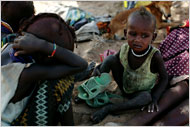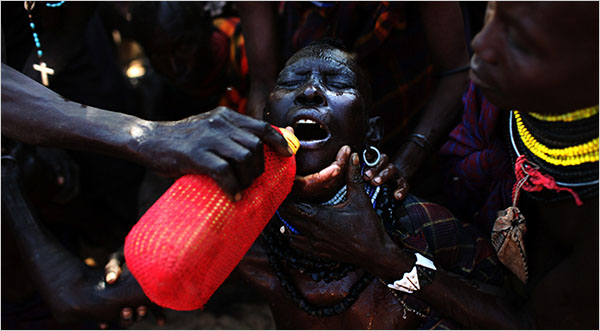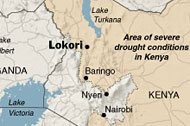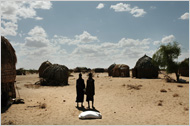LOKORI, Kenya — The sun somehow feels closer here, more intense, more personal. As Philip Lolua waits under a tree for a scoop of food, heat waves dance up from the desert floor, blurring the dead animal carcasses sprawled in front of him.
Multimedia

Children waited in Lokori for aid last month. Communities are fighting over the few remaining pieces of fertile grazing land. More Photos »
So much of his green pasture land has turned to dust. His once mighty herd of goats, sheep and camels have died of thirst. He says his 3-year-old son recently died of hunger. And Mr. Lolua does not look to be far from death himself.
“If nobody comes to help us, I will die here, right here,” he said, emphatically patting the earth with a cracked, ancient-looking hand.
A devastating drought is sweeping across Kenya, killing livestock, crops and children. It is stirring up tensions in the ramshackle slums where the water taps have run dry, and spawning ethnic conflict in the hinterland as communities fight over the last remaining pieces of fertile grazing land.
The twin hearts of Kenya’s economy, agriculture and tourism, are especially imperiled. The fabled game animals that safari-goers fly thousands of miles to see are keeling over from hunger and the picturesque savanna is now littered with an unusually large number of sun-bleached bones.
Ethiopia. Sudan. Somalia. Maybe even Niger and Chad. These countries have become almost synonymous with drought and famine. But Kenya? This nation is one of the most developed in Africa, home to a typically robust economy, countless United Nations offices and thousands of aid workers.
The aid community here has been predicting a disaster for months, saying that the rains had failed once again and that this could be the worst drought in more than a decade. But the Kenyan government, paralyzed by infighting and political maneuvering, seemed to shrug off the warnings.
Some government officials have even been implicated in a scandal to illegally sell off thousands of tons of the nation’s grain reserves as a famine was looming.
So far, a huge, international aid operation to avert mass hunger has not kicked in, or at least not to the degree needed. The United Nations World Food Program recently said that nearly four million Kenyans — about a tenth of the population — urgently needed food.
“Red lights are flashing across the country,” the agency said.
But donor nations have been slow to respond, and a United Nations-led emergency appeal for $576 million is less than half financed.
Part of the reason may be the growing disappointment with Kenya’s leaders. They have been poked and prodded by Western ambassadors — and their own citizens — to overhaul the justice system, the police force and the electoral commission. The outcry followed a widely discredited election in 2007 that set off a wave of violence, claiming more than 1,000 lives.
But Kenyan politicians seem more preoccupied with positioning themselves for the next election in 2012 than with cleaning up the mess from the last one. Few reforms have been accomplished and corruption continues to flourish, as the grain scandal currently under investigation has made painfully clear.
“At a time like this, we need donor confidence,” said Nicholas Wasunna, a humanitarian adviser for the aid group World Vision. But he said that donors might be put off by “the politics of what’s happening in the country.”
The arid lands of northern Kenya have been the hardest hit. In some villages, it has not rained in years. But the drought has become a problem nationwide.
In Baringo, in the Rift Valley, people are eating cactus because corn and wheat have gotten so expensive. In Nyeri, in central Kenya, some have turned to pig feed. In Nairobi, the capital, even the fanciest neighborhoods often go without running water for a week. And it is dark too. Kenya relies on hydropower for electricity, so less rainfall means less power.
The Kenyan government has begun to respond, organizing some highly publicized food deliveries to famine-prone areas. But many Kenyan officials almost seem in denial.
Chaunga Mwachaunga is the acting district officer in Lokori, an especially parched town in northern Kenya. He bristled when presented with reports that dozens of children in his area had recently died of hunger.
“Hunger? How do we know they died of hunger?” he said. “I know there’s not enough food for people, but we can be sure that nobody will die of hunger while the Kenyan government is here. Show me the death certificates.”
It is hard to find any death certificates when there are few hospitals. Entering this area is like stepping back in time.
Lokori is home to the Turkana, who cling tightly to their traditions. The women wear wreaths of beads and shave their hair into Mohawks. The men scar their backs in puffy patterns and wear disc-like bracelets that double as razors. They live in gumdrop-shaped huts scattered across the sandy plateau and herd animals to survive.
Even in a good year, life here is extremely precarious. But this year malnutrition rates among the Turkana have soared way past emergency thresholds.
Turkana children, dressed in little more than a sheet, are hiking 20 miles for a gallon of water. Turkana men are abandoning families, simply vanishing into the desert because they cannot face the shame of being unable to feed their children. Many people here now have nothing to eat but the chalky, bitter fruits that grow wild in the desert. They smash them open with rocks to get at the barely edible part inside.
World Vision is distributing emergency rations to the worst-off areas. The other day, Mr. Lolua, who said he lost his 3-year-old son in June, waited with a group of men under a thorn tree for a scoop of porridge.
Another whisper of a man named Ekitela was so skinny and his hands shook so much he could barely hold the cup he had been given.
“I’m not as old as I look,” he said. “It’s just I don’t have any food.”
He then started choking on the porridge, which was the color and texture of sand, and was rescued by a capful of water from his granddaughter.
Perhaps equally worrisome is the rising ethnic conflict. The Turkana call their neighbors, the Pokot, ”the enemy” and said intense clashes recently broke out because of the shrinking amount of grazing land. One Turkana woman said “the enemy” had killed her son, stolen all her animals and driven her off her land.
Meteorologists predict rains will be coming by October, and they may even bring the other extreme from present conditions. Another El Niño cycle is forecast, which after years of drought and earth baked to a rock-hard crust could bring the opposite problem: floods.



